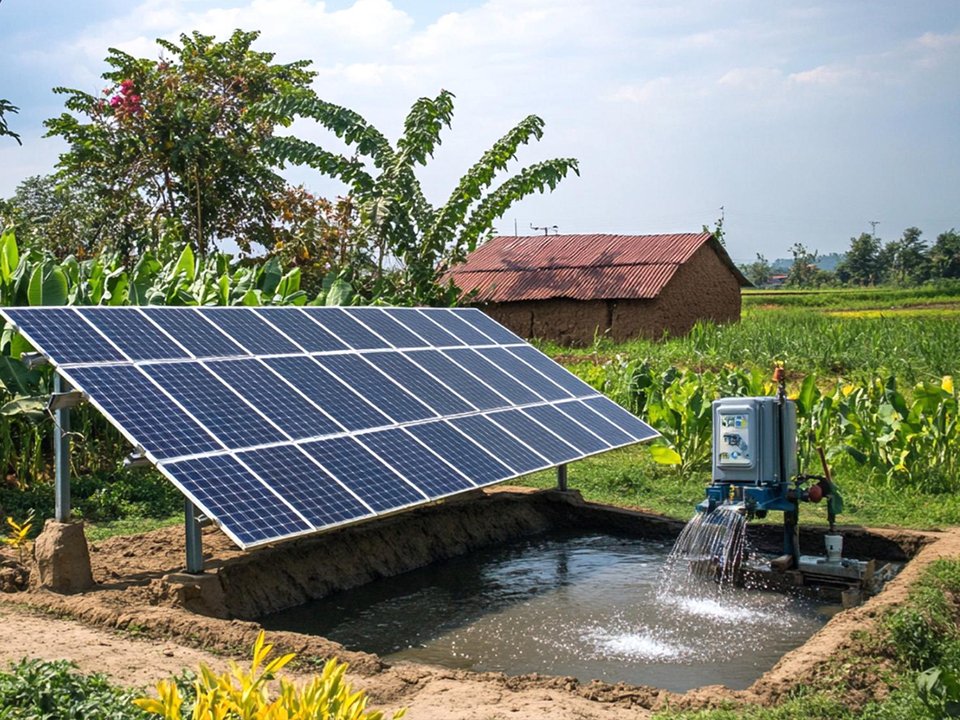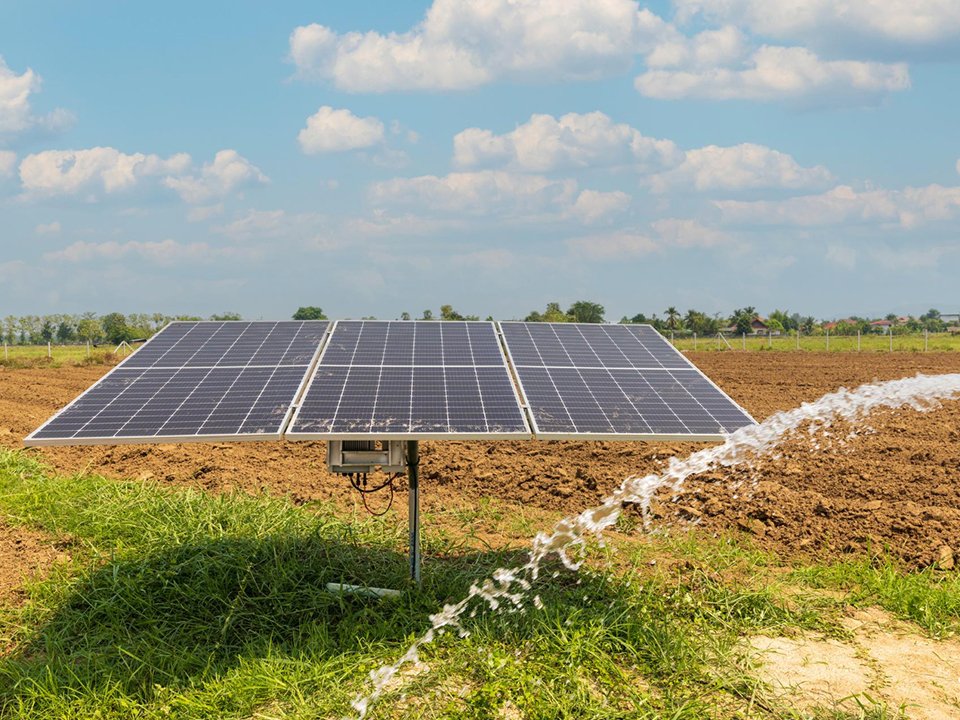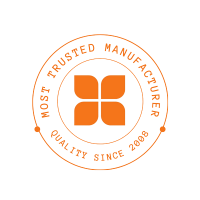Water pumps are essential for agriculture, domestic use, and rural communities. They provide guaranteed access to water for irrigation, cattle, and domestic use. Currently, there are two primary alternatives available in the market: solar pumps and traditional pumps.
Traditional pumps typically use diesel or electricity, whereas solar pumps are powered by free, renewable sunlight. As fuel prices go up and power cuts are frequent, most farmers and residential homeowners in India are turning towards solar power.
This blog compares solar pumps with traditional pumps in terms of cost, efficiency, maintenance, and long-term value, enabling you to determine which option is preferred.
Solar Pump vs. Traditional Pump: Key Differences Explained
When comparing a solar pump with a traditional pump, the differences become clear in areas like cost, efficiency, power source, maintenance, and durability. Here’s the breakdown of how each factor sets them apart:
| Factor | Solar Pump | Traditional Pump |
|---|---|---|
| Cost | Requires higher upfront investment, with operating costs that are minimal, leading to long-term savings.Requires higher upfront investment, with operating costs that are minimal, leading to long-term savings. | Lower initial purchase cost, but heavy recurring expenses for fuel or electricity. |
| Power Source | Runs on renewable energy from the sun. Best suited for off-grid and rural areas. | Reliable in urban areas with stable power or fuel supply, but challenging in remote locations. |
| Efficiency | Efficient in sunny climates and can be paired with storage systems to function during cloudy days. Saves money in the long term as there are no fuel expenses. | Provides a consistent water supply regardless of weather, but efficiency is tied to rising energy costs and grid/fuel availability. |
| Maintenance | With fewer moving parts, solar pumps require minimal maintenance, which includes simple tasks like cleaning the panels and occasionally checking the wiring, which are usually sufficient. | Requires frequent servicing, such as oil changes, fuel management, and mechanical part replacements, which adds to the running cost. |
| Durability | Solar panels last 20–30 years, and pumps can function effectively for 10–15 years with minimal servicing. | Durable, but parts wear out faster due to heavy use and fuel combustion, resulting in shorter lifespans and higher replacement frequency. |
While traditional pumps are cheaper to install initially and provide consistent performance in areas with reliable electricity or fuel, solar pumps save money in the long run thanks to zero fuel costs, low maintenance, and longer lifespan.
Benefits of Solar Pumps
Solar water pumps are increasingly in use since they offer several advantages over traditional pumps. The major advantages are as follows:
1. Environment-Friendly and Sustainable:
Solar pumps use pure renewable energy from the sun and do not require the use of fossil fuels. This cuts down greenhouse emissions and combats climate change.
2. Major Cost Savings:
Though the initial cost is higher, solar pumps have nearly negligible running expenses, as sunlight is free. With little maintenance and no electricity or fuel bills, consumers end up saving money in the long term.
3. Reliable in Remote and Off-Grid Locations:
Solar pumps are well-suited to villages, farms, and areas with no steady power supply.
4. Less Maintenance and Longer Life:
Having fewer moving parts than traditional pumps, solar pumps need little maintenance. Solar panels themselves tend to last 20–25 years, and the pumps themselves can last more than a decade with minimal upkeep
5. Enhances Sustainability for Household and Agricultural Use:
Farmers see solar pumps as round-the-clock irrigation with no increasing costs of fuel. Rural families have continuous access to safe drinking water. Such affordability, strength, and availability make solar pumps a future sustainable investment.
Challenges with Traditional Pumps
Traditional pumps have been in use for many decades, but with a few drawbacks that render them less convenient in the contemporary sense:
1. High Energy and Fuel Expenses:
Traditional pumps are either operated using grid electricity or fossil fuels like diesel and kerosene. As energy costs continue to go up, this incurs large recurring costs. In the long run, fuel expenses can significantly outweigh the initial cost savings of purchasing an inexpensive pump.
2. Regular Maintenance Requirements:
Traditional pumps have numerous moving parts that need frequent servicing.
3. Heavy Running Costs:
Aside from fuel and maintenance, traditional pumps also need skilled technicians for maintenance and repairs.
4. Negative Environmental Impact:
The use of fossil fuel-fueled pumps releases toxic gases and causes air and land pollution. Their dependence on non-renewable energy sources also leads to higher carbon emissions, thereby making them less environmentally friendly than solar options.


Cost and Long-Term Benefits
When comparing solar pumps with traditional pumps, it becomes clear that costs vary over time depending on several factors.
| Factor | Solar Pump | Traditional Pump |
|---|---|---|
| Upfront Cost | Higher initial investment due to solar panels, inverter, and installation. | Lower purchase and installation costs make it attractive for tight budgets. |
| Operating Cost | Runs on free solar energy, with near-zero running expenses. | Reliable in urban areas with stable power or fuel supply, but challenging in remote locations. |
| Maintenance Cost | Maintenance is minimal, requiring only regular panel cleaning and occasional wiring checks. | Frequent servicing, oil changes, and professional repairs increase expenses. |
| Long-Term Value | Pays for itself within 3–5 years through savings; economical for decades. | Appears cheap at first, but high fuel/electricity costs make it costly over time. |
Guide to Operation and Maintenance
To keep a solar pump running smoothly with minimal hassle, follow these simple maintenance tips:
Choosing the Right Pump: Solar vs Traditional
Selecting the right water pump is crucial because it directly affects water availability, operational costs, and long-term efficiency. The wrong pump can lead to frequent breakdowns, higher fuel or electricity bills, and wasted time on maintenance. For farms and households, a pump that doesn’t match water demand or location can disrupt irrigation schedules, reduce crop yield, or limit access to safe water.
Choosing the right pump helps in a reliable water supply, cost savings, and sustainable operation for years to come.
| Factor | Best for Solar Pump | Best for Traditional Pump |
|---|---|---|
| Location | Remote/off-grid areas | Grid-connected areas |
| Budget | Long-term investment | Tight initial budget or short-term use |
| Water Demand | Medium to high, sustainable irrigation | Moderate demand with reliable electricity/fuel. |
| Environmental Goal | Eco-friendly, low carbon footprint | Relies on fossil fuels/electricity, higher emissions |
FREE SOLAR EXPERT CONSULTATION
Conclusion
Warranties are a great starting point, but real-world performance and maintenance will ultimately determine the longevity and value of your solar investment. Understanding both is key to making a confident, long-term decision. Solar panels are built to last, but understanding their lifespan, proper maintenance, and warranty coverage can help you get the most out of your investment. With modern panels offering higher efficiency and lower degradation rates, upgrading older systems is often a smart move, especially if your current setup is underperforming. For long-term savings and reliability, consider exploring advanced solar solutions from trusted providers like Alpex Solar, known for delivering high-quality, durable solar technology.




